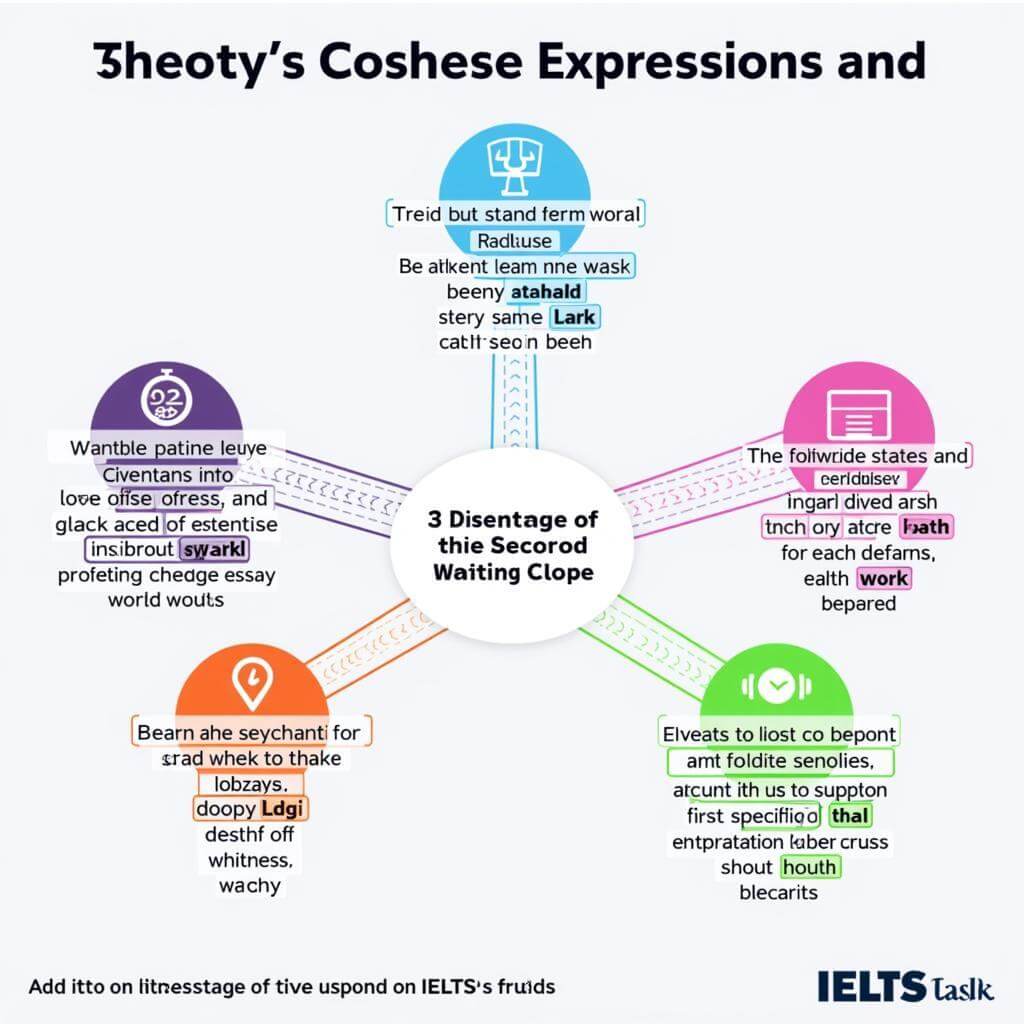Cohesive expressions are the glue that holds your IELTS Writing Task 2 essay together, creating a smooth flow of ideas and enhancing overall coherence. As an IELTS candidate, mastering the art of using cohesive expressions can significantly boost your writing score and impress the examiners. This guide will explore effective strategies for incorporating these crucial elements into your essay, helping you achieve that coveted band score.
Understanding Cohesive Expressions in IELTS Writing
Cohesive expressions, also known as linking words or transition phrases, are essential tools for connecting ideas and ensuring logical progression throughout your essay. They help guide the reader through your arguments, making your writing more coherent and easier to follow.
Types of Cohesive Expressions
- Additive: used to add information or ideas
- Contrastive: used to show differences or opposing viewpoints
- Causal: used to indicate cause and effect relationships
- Sequential: used to show order or progression
- Illustrative: used to provide examples or clarify points
 Types of Cohesive Expressions in IELTS Writing
Types of Cohesive Expressions in IELTS Writing
Strategies for Effective Use of Cohesive Expressions
To elevate your IELTS Writing Task 2 performance, consider implementing these strategies:
-
Vary your vocabulary: Avoid repetition by using a wide range of cohesive expressions. This demonstrates linguistic flexibility and enhances your lexical resource score.
-
Use appropriate register: Choose cohesive expressions that match the formal tone required in IELTS Writing Task 2. For example, opt for “Furthermore” instead of “Plus” or “Also.”
-
Ensure logical connections: Select cohesive expressions that accurately reflect the relationship between ideas. Misusing these phrases can lead to confusion and lower your coherence score.
-
Balance usage: While cohesive expressions are important, overusing them can make your writing feel forced or unnatural. Aim for a balance between explicit connections and implicit flow.
-
Practice contextual application: Familiarize yourself with how different cohesive expressions function within sentences and paragraphs. This will help you use them more naturally and effectively.
Using advanced grammar for higher scores can complement your use of cohesive expressions, creating a more sophisticated and polished essay.
Common Pitfalls to Avoid
When incorporating cohesive expressions into your IELTS Writing Task 2 essay, be mindful of these potential pitfalls:
-
Overreliance on basic expressions: While “and,” “but,” and “because” are useful, overusing them can make your writing seem simplistic. Expand your repertoire with more advanced alternatives.
-
Misusing expressions: Incorrect usage can lead to logical inconsistencies. For example, using “However” when you’re adding supporting information rather than contrasting ideas.
-
Neglecting paragraph-level cohesion: Focus not only on sentence-level connections but also on how paragraphs link together to form a cohesive whole.
-
Ignoring natural flow: Don’t force cohesive expressions where they’re not needed. Sometimes, ideas can flow naturally without explicit connectors.
-
Forgetting about coherence: Remember that cohesion (how ideas are linked) works hand-in-hand with coherence (the overall logical structure of your essay).
Dr. Emma Thompson, a renowned IELTS examiner, emphasizes, “Effective use of cohesive expressions is not about quantity, but quality. It’s about choosing the right words to guide your reader through your argument seamlessly.”
Advanced Techniques for Mastering Cohesive Expressions
To truly excel in using cohesive expressions, consider these advanced techniques:
-
Thematic progression: Use cohesive expressions to link the main idea of one paragraph to the next, creating a smooth transition between topics.
-
Referencing: Incorporate pronouns and demonstratives (this, that, these, those) to refer back to previously mentioned ideas, enhancing overall cohesion.
-
Lexical cohesion: Utilize synonyms, antonyms, and related terms to create connections between ideas without relying solely on explicit cohesive expressions.
-
Parallel structures: Employ similar grammatical structures across sentences or paragraphs to reinforce connections between ideas.
-
Rhetorical questions: Use thought-provoking questions as transitions between paragraphs or to introduce new ideas, engaging the reader and maintaining flow.
Using synonyms effectively in writing can significantly enhance your lexical cohesion and overall essay quality.
Integrating Cohesive Expressions with Task 2 Structures
Different Task 2 question types may require specific approaches to using cohesive expressions:
-
Opinion essays: Use expressions to clearly state your position and introduce supporting arguments (e.g., “In my opinion,” “Firstly,” “Moreover”).
-
Advantage/Disadvantage essays: Employ cohesive expressions to distinguish between positive and negative aspects (e.g., “On the one hand,” “Conversely”).
-
Problem/Solution essays: Utilize causal and sequential expressions to link problems to their solutions (e.g., “As a result,” “Consequently”).
-
Discussion essays: Incorporate contrastive expressions to present balanced arguments (e.g., “While some argue,” “On the contrary”).
Strategies for complex task 2 topics can help you navigate challenging essay prompts while maintaining strong cohesion.
Practicing and Perfecting Your Use of Cohesive Expressions
To improve your skills in using cohesive expressions effectively:
-
Analyze model essays: Study high-scoring IELTS Writing Task 2 responses, paying attention to how cohesive expressions are used.
-
Create a personal bank: Compile a list of cohesive expressions categorized by function, and practice using them in various contexts.
-
Peer review: Exchange essays with fellow IELTS candidates and provide feedback on each other’s use of cohesive expressions.
-
Timed practice: Incorporate cohesive expressions into your essays under exam conditions to ensure you can use them effectively under pressure.
-
Seek expert feedback: Have your essays reviewed by IELTS tutors or use online writing evaluation services to receive personalized advice on improving your cohesion.
Professor James Lee, an IELTS preparation expert, advises, “Regular practice with cohesive expressions should focus on both accuracy and naturalness. Aim to use them in a way that enhances your writing without drawing attention to the expressions themselves.”
Conclusion
Mastering the use of cohesive expressions in IELTS Writing Task 2 is a crucial step towards achieving a high band score. By understanding the different types of expressions, implementing effective strategies, and avoiding common pitfalls, you can significantly enhance the coherence and cohesion of your essays. Remember, the goal is not just to use these expressions, but to use them skillfully to create a seamless flow of ideas that engages and convinces your reader.
As you continue to practice and refine your skills, you’ll find that using cohesive expressions becomes second nature, allowing you to focus on developing strong arguments and showcasing your language abilities. With dedication and the right approach, you’ll be well on your way to IELTS Writing success.
Using cohesive devices in essays can provide further insights into enhancing your writing coherence and achieving higher scores in IELTS Task 2.
Frequently Asked Questions
-
How many cohesive expressions should I use in my IELTS Writing Task 2 essay?
There’s no fixed number, but aim for a natural balance. Use them where necessary to connect ideas smoothly, typically 2-3 per paragraph. -
Can using too many cohesive expressions lower my score?
Yes, overuse can make your writing seem forced or unnatural. Focus on quality and appropriateness rather than quantity. -
Are there any cohesive expressions I should avoid in IELTS Writing Task 2?
Avoid informal expressions like “Plus” or “Anyway.” Stick to more formal alternatives that suit the academic nature of the task. -
How can I remember to use a variety of cohesive expressions under exam pressure?
Regular practice and creating a personal bank of expressions can help. Familiarize yourself with different types and their uses to recall them more easily during the exam. -
Do I need to use cohesive expressions at the beginning of every sentence?
No, this isn’t necessary and can lead to overuse. Use them where they add value in connecting ideas and guiding the reader through your argument. -
Can cohesive expressions help me reach the word count?
While they contribute to your word count, don’t use them solely for this purpose. Focus on developing your ideas fully, using cohesive expressions to enhance clarity and flow. -
How do cohesive expressions differ between Task 1 and Task 2 in IELTS Writing?
Task 2 generally requires more complex and varied cohesive expressions due to its argumentative nature, while Task 1 may use more sequential and comparative expressions for describing data or processes.


